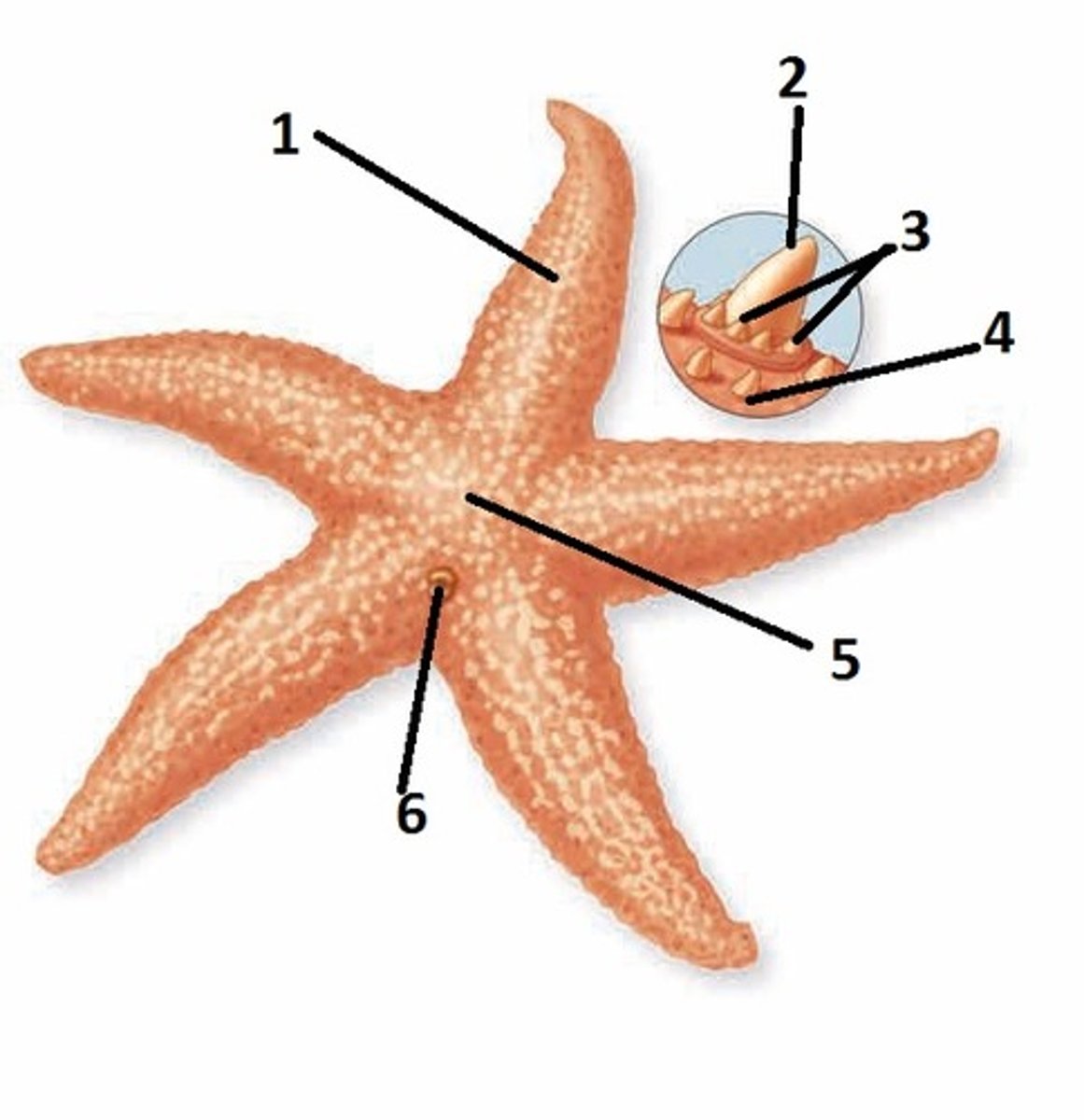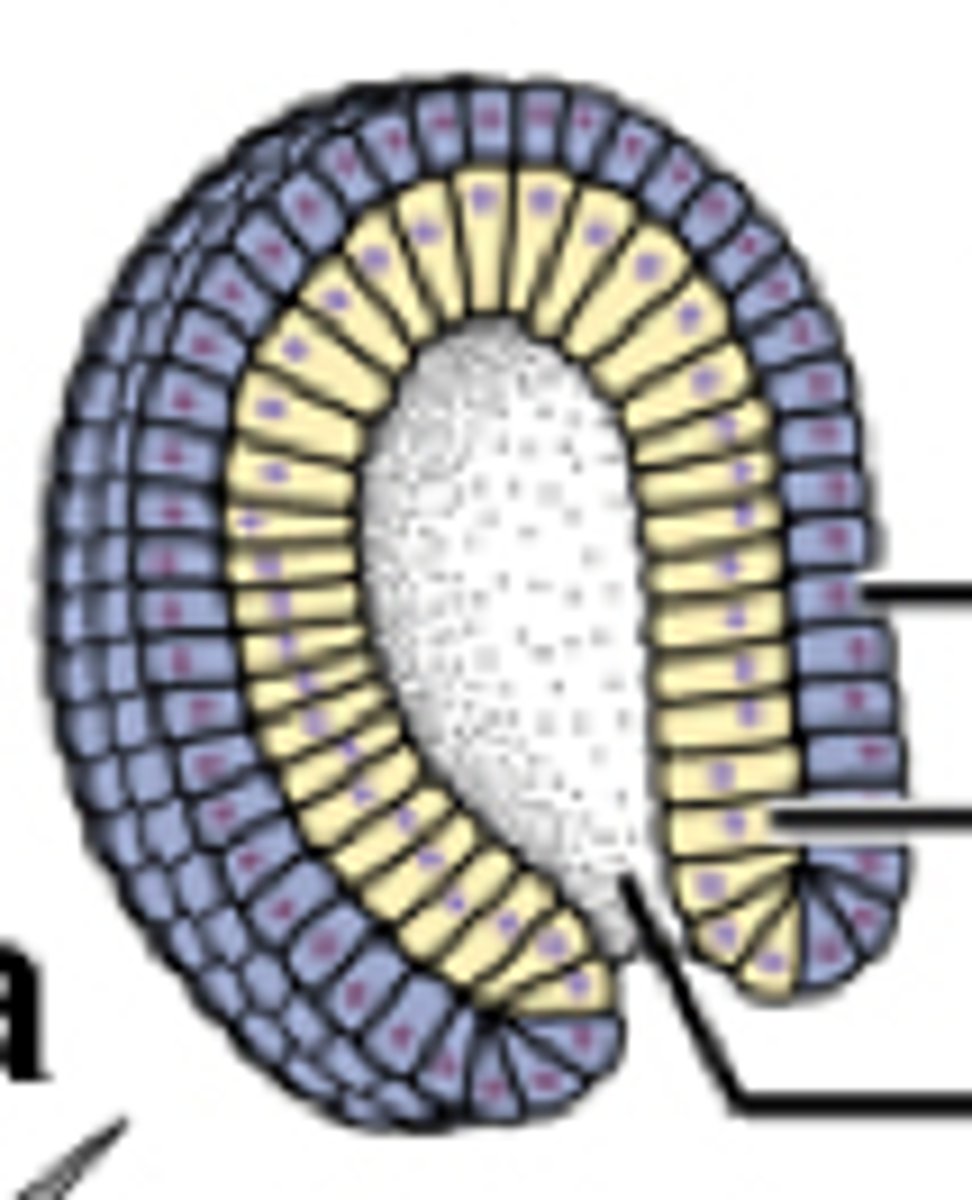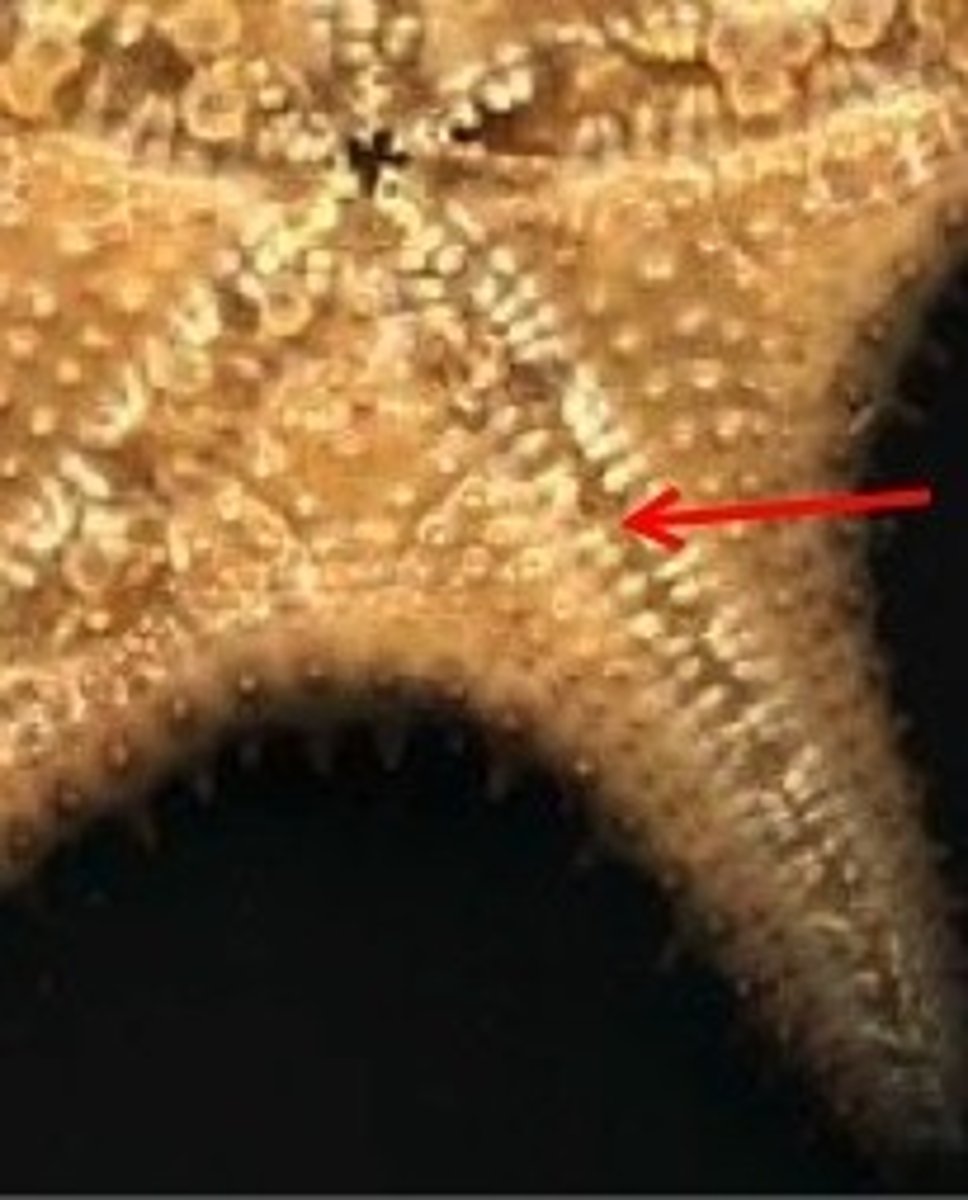BLG 316: Chapter 14 - Echinoderms and Hemichordata
1/63
There's no tags or description
Looks like no tags are added yet.
Name | Mastery | Learn | Test | Matching | Spaced |
|---|
No study sessions yet.
64 Terms
periproct
Region located around the anus and a site of waste release
- in sea urchin, this area contains the anus and madreoporite on the aboral surface

Echinodermata
radially symmetrical marine invertebrates including e.g. starfish and sea urchins and sea cucumbers
- loss of gail slits
- pentaradial
-endoskeleton of stereom ossicles
Why are echinoderms named that?
spiny skin
Unique characteristics of echinoderms include all of the following EXCEPT
A. an endoskeleton of plates or ossicles.
B. marine, freshwater, and terrestrial species.
C. pedicellariae.
D. dermal brachiae
E. a water vascular system.
b. marine freshwater and terrestrial species.
Echinoderms are
A. mostly pelagic or free-swimming in the open ocean.
B. benthic.
C. parasitic.
D. mostly particle feeders.
E. fish predators.
b. benthic
Ecologically, sea stars are at what trophic level?
A. Producer
B. Herbivore
C. Top carnivore
D. Omnivore
E. Detritivore
c. top carnivore
Tube feet run along the ________ groove that extends along the oral side from the mouth to the tip of each arm.
Ambulacral
The oral tentacles of the sea cucumber are
modified tube feet
benthic
bottom of an aquatic ecosystem; consists of sand and sediment and supports its own community of organisms
The orientation of a sea star is
A) a dorsal mouth and a ventral spiny surface facing upward.
B) an oral mouth facing downward and an aboral spiny surface.
C) an anterior mouth and a posterior spiny surface.
D) a dorsal oral mouth and a ventral-aboral spiny surface.
E) a ventral mouth and an anti-ventral spiny surface.
B. oral-aboral body symmetry. the oral end faces down and the aboral end faces up
asteroidea common name
sea stars
sea star external anatomy
five arms that taer gradually into round body disc
oral aboral orientation
pincer like pedicellarie
ambalacrum
ambulacrum groove runs from the mouth to the tip of each arm
- bordered by rows of tube feet
rows of tube feet are bordered by movable spines
sea star internal anatomy
- radial nerve in center of ambulacral grooves
- radial canal located under nerve
- water vascular system - coelom
- ossicles or other dermal tissue covers these structures (except crinoids)
Pedicellariae in Sea Stars are
A. larval sea stars.
B. the mouth-like openings into the center of the bottom of the sea star.
C. structures linking the madreporite and the ring canal.
D. small pincer-like projections clustered on the skin of a sea star which serves to keep it clean of parasites and aquatic growth.
E. soft and delicate projections of the coelomic cavity covered with epidermis.
D. small pincer like projections clustered on the sin of a sea star that serves to keep it clean of parasites and aquatic growth

asteroid water vascular system
- coelomic copartment consisting of system of cnalas and tube feet
- radial canals diverge from a ring canal and extend into each ray
- function in locomotion, food gathering, respiration and excretion
- operates hydraulically
- ampulla muscles contract, forcing fluid into and extending the podium
- contraction of tube foot longitudinal muscles retracts it, forcing fluid back into ampulla
ampulla
dilated portion of a canal or duct
A sea star that you are observing is unable to receive any water into the water vascular system. Where should you look for a blockage?
A. Aristotle's lantern
B. Pedicellariae
C. Madreporite or sieve plate
D. Ambulacrum
madreoporite or sieve plate
asteroida feeding and digestive system
- mouth leads to two part stomach in central disc
- large lower cardiac stomach can be everted through the mouth during feeding
- upper pyloric stomach is smaller
- connected to pyloric ceca in each arm
- digestion mostly extracellular in pyloric ceca
- anus is inconspicuous
consume a wide range of food: mostly invertebrates, some vertebrates, some particle feeding
asteroid nervous and sensory system
- echinoderms lack brain and distinct ganglia
- nervous system has three sub systems (nr, nrc, p)
- epidermal nerve plexus (nerve net) connects the systems
- sense organs include an eye spot at the tip of each arm
- sensory cells scattered over the epidermis
three subsystems of asteroid nervous and sensory system
- circumoral nerve ring (nr)
- radial nerve cord (nrc)
- dorsal papillae (P)
these subsystems occur at different levels in the arms
asteroida reproductive system development
- most sea stars produce free swimming larvae
- deuterostome pattern
- main coelomic compartments (somatocoels) arise from posterior blastocoel
- left hydrocoel become water vascular system
- left axocoel becomes stone canal and perihemal channels
echinoderms larvae
1. bippinnaria stage
- free swimming larva, has cilia arranged in bands
-ciliated tracts become larval arms
- larva grows three adhesive ams and a sucker at the anterior
2. brachiolaria stage
- attached to substrate
- undergoes metamorphosis into a radial juvenile
- arms and tube feet appear, animal detaches and becomes a young sea star
Deuterostomes
Animals in which the blastopore becomes the anus during early embryonic development
blastopore
The opening of the archenteron in the gastrula that develops into the mouth in protostomes and the anus in deuterostomes

sea stars reproduce mostly:
A. by budding.
B. only asexually by intentionally breaking off appendages.
C. sexually, usually with separate sexes.
D. sexually, with both sex organs on same organism, similar to earthworms, with cross-fertilization.
E. sexually, with both sex organs on same organism, but by self-fertilization
c. sexually, usually with separated sexes
If you are trying to locate the main coelomic compartment in an echinoderm, where should you look?
A. The main coelomic compartment is missing.
B. The main coelomic compartment is a somatocoel.
C. The main coelomic compartment is completely converted into the water-vascular system.
D. The main coelomic compartment is the pyloric stomach.
E. The main coelomic compartment is restricted to a small space around the gonads.
b. the main coelomic compartment is a somatocoel
"Bipinnaria" describes the
A. larval form of many echinoderms.
B. central two-branched reproductive structures of sea stars.
C. hydraulic system that controls the tube feet of sea urchins and sea stars.
D. ability of these animals to grow into either males or females.
E. underlying bilateral symmetry of an adult although it appears to be pentaradial
a. larval form of many echinoderms
sea urchin external anatomy
-shell has 10 double rows of plates with movable, stiff spine
-tube feet extend along the 5 ambulacral rows
-spines moved by small muscles at the bases
-three jawed
pedicellarie mounted on long stalks are most common types
- have pedicellarie with venom glands
-mouth surrounded by converging teeth
- branched fills encircling the region around the mouth
-anus, genital pores and madreoporite are aboral
sea urchin internal anatomy
-ciliated siphon connects esophagus to intestine
-ambulacral grooves are closed; radial canals run just beneath the test in each ambulacral radius
ambulacral groove
A channel along the oral surface of echinoderms through which the tube feet protrude

Aristotle's lantern
-conical complex set of chewing structures with the exoskeletal test (shell)
-attached to mouth and teeth
-auricles connect the retractor muscles to the shell
-protractor muscle is attaches to the test
-esophagus is at the end posterior
-jawlike mechanisms of sea urchins that involves the mouth and teeth
-contains mouth and pharynx

Test of a sea urchin
hard internal skeleton
made of 10 fused plates
surrounded by epidermis
peristome
A ring of interlocking, tooth-like structures on the upper part of a moss capsule (sporangium), often specialized for gradual spore discharge.
madreoporite
Opening that leads to the water vascular system
siphon
absorbs water and nutrients in digestie system
tube that runs along the intestine
gonophore
a structure where the gonads are released
the complex chewing apparatus found in many sea urchins is the
aristotle's lantern
echinoid reproduction and life history
- sexes separate
- gametes are shed into sea for external fertilization
- echinopluteus larvae may live a planktonic existence before becoming young urchin
acorn worm external anatomy
mucus covered body has three parts:
1. tongue like proboscis
2. short collar
3. long trunk
many deposit feeders: some suspension feeders
no gills
hemichordates live
A. in the open ocean with a similar lifestyle to arrowworms (which is why they are considered related).
B. in kelp beds.
C. in deep oceans, especially the rich and oxygenated Arctic Ocean.
D. on the bottom of shallow oceans, sometimes colonially and in secreted tubes.
E. just around thermal vents.
d. on the bottom of shallow oceans, sometimes colonially and in secreted tubes
Hemichordates show relationships to
A. arthropods and annelids.
B. molluscs and echinoderms.
C. annelids and echinoderms.
D. echinoderms and chordates
d. echinorderms and chordates
acorn worm: food, feeding and gas exchange process
- mainly deposit feeders but also suspension feeder
- muscular proboscis help to collect food in mucus strands on its surface
- food laden mucus continues to be directed by cilia along ventral part of pharynx and esophagus to intestine
deposit feeders
ingest organic material that has been deposited within a substrate or on its surface
suspension feeders
An aquatic animal, such as a clam or a baleen whale, that sifts small food particles from the water
acorn worm: respiratory system
- a row of gill pores extended dorso laterally on each side of the trunk just behind the collar
- have no gills, but some respiratory gas exchange occurs in the vascular branchial; epithelium as well as on the body surface
acorn worm: nervous and reproductive process
- acorn worms have a ventral nerve cord and a larger dorsal nerve cord that os hollow in some species
- sexes are separate and fertilization is external
- in some species. a ciliated tornaria larva develops that closely resembles the echinoderm bipinnaria
Explain the hemichordate "notochord"
A. It is the feature proposed by Bateson to include this animal with the chordates.
B. It is a buccal diverticulum.
C. It is not homologous with the chordate notochord.
D. All of the choices are correct.
E. None of the choices are correct
d. all of the choices are correct
the gill slits of enteropneust hemichordates function to
A. house gills.
B. strain food out of the water on the mucus-coated gill slits.
C. allow water to exit after food has been gathered from the inflow.
D. orient the animal in the water.
E. excrete wastes.
c. allow water to exit after flood has been gathered from the inflow
The excretory system of an enteropneust hemichordate (or acorn worm) consists of
A. a glomerulus or network of blood vessels that surround the sinus and buccal diverticulum.
B. a rich supply of blood vessels in the gill slits.
C. a simple metanephridium that empties into the cloaca.
D. a network of vessels under the epidermis.
a. glomerulus or network of blood vessels that surround the sinus and buccal diverticulum
The larva of an acorn worm is
A. is always a juvenile that grows into a bigger adult.
B. a tornaria larva that resembles an echinoderm bipinnaria larva.
C. is very close in structure to a tunicate larva.
D. nearly identical to a lancelet.
E. None of the choices are correct.
b. a tornaria larva that resembles an echinoderm bipinnaria larva
Which characteristic of the Hemichordata serves as an indication that nervous coordination is about to become a significant adaptive leap forward for some members of the deuterostomes?
A. The pharyngeal slits
B. An coelom divided into three cavities
C. A dorsal nerve cord
D. The well-developed proboscis
c. a dorsal nerve cord
What is a notochord?
A flexible rod that supports a chordate's back

Tornaria
a free swimming larva of enteropneusts (acorn worm that rotates as it swims; resembles somewhat the bipinnaria larva of echinoderms
Acorn worm circulatory system
- above buccal diverticulum - heart, which receives blood carried forward from a dorsal blood vessel
- blood pumped from heart flows into a network of blood sinuses
acorn worm excretory system
- glomerulus, which has an excretory function, and which has an excretory function, and then flows posteriorly through a ventral blood vessel, passing through extensive sinuses in body wall and gut.
Exchange of respiratory gases in enteropneusts is accomplished at the gill slits and by
a. active transport in the tracheal system.
b. diffusion across the body wall.
c. facilitated diffusion in book gills.
d. diffusion in alveolar lungs.
e. facilitated diffusion in dermal branchiae.
b. diffusion across the body wall
The common name acorn worm is derived from the appearance of the __________ of these worms.
a. trunk
b. hepatic cecum
c. collar
d proboscis.
e.tunic
d. proboscis
Which of the following animals is not in the phylum Chordata?
a. lampreys
b. acorn worms
c. sea squirts
d. salps
e. hagfish
b. acorn worms
__________ cells in the circulatory system of tunicates accumulate nitrogenous
wastes.
a. Erythrocyte
b. Ameboid
c. Exocyte
d. Endocyte
e. Lymphoid
b. Ameboid
How do the tube feet of sea stars and sea urchins operate.
A. Sticky threads lead back to the mouth and primitive brain.
B. Cilia transport hemolymph from chamber to chamber.
C. Actin and myosin in muscles in the five arms or "rays" constrict the tube feet directly when stimulated by nerves from the sea star brain.
D. A hydraulic system regulates water pressure in the tube feet.
E. Each tube foot is an independent organism and the sea star is a colonial mass.
D. A hydraulic system regulates water pressure in the tube feet
Brittle stars differ from sea stars by
a) lacking pedicellariae.
b) lacking papulae, intestine, or an anus.
c) having the ambulacral grooves closed and covered with arm ossicles.
d) having tube feet without suckers.
e) all of the choices are correct distinctions.
c. having the abulacral grooves closed and covered with arm ossicles
Predict what would cease if the papulae of a sea star became nonfunctional.
A. Respiration
B. Excretion
C. Reproduction
D. Digestion
E. Defense and protection
A. respiration
The larva of an acorn worm is
a) always a juvenile that grows into a bigger adult.
b) a tornaria larvae that resembles an echinoderm bipinnaria larvae.
c) very close in structure to a tunicate larva.
d) nearly identical to a lancelet.
e) None of the choices are correct.
B. a tornaria larvae that resembles an echinoderm bipinnaria larvae